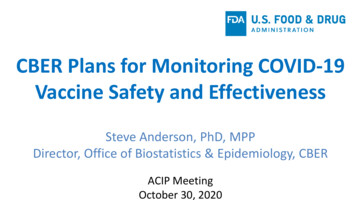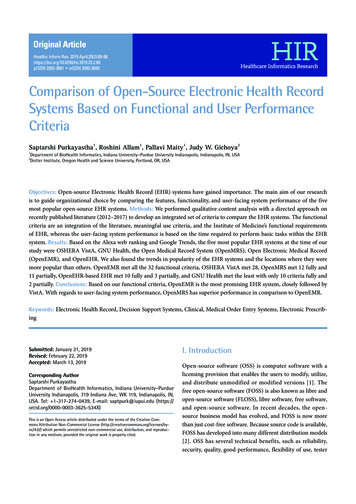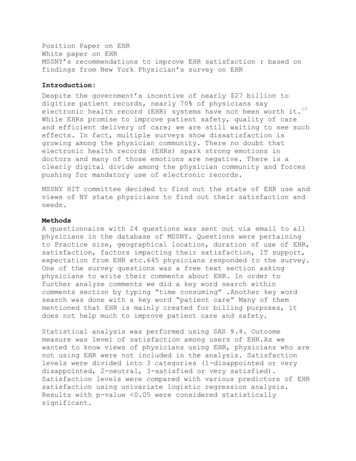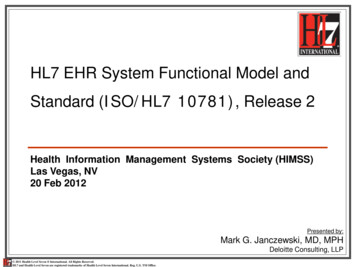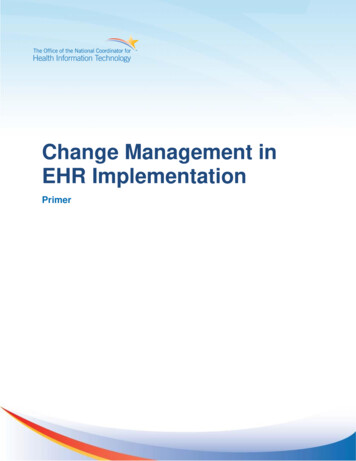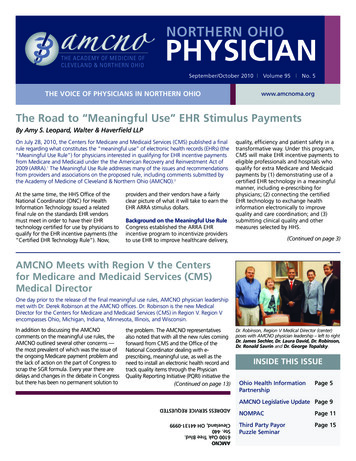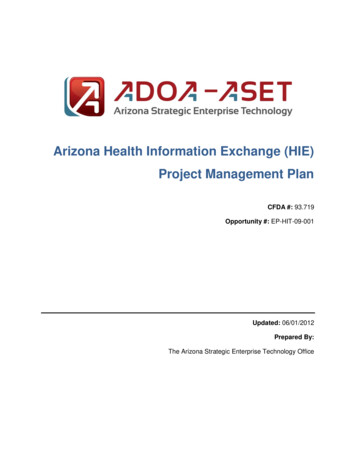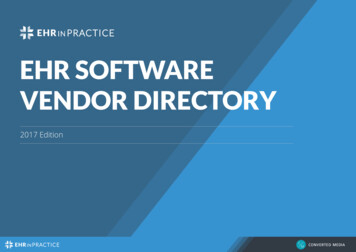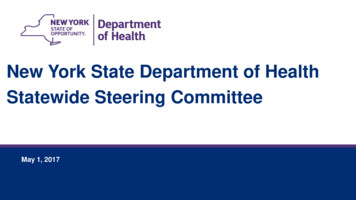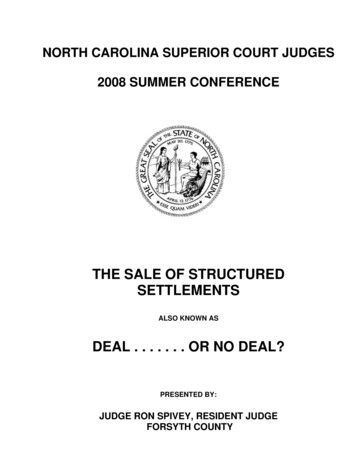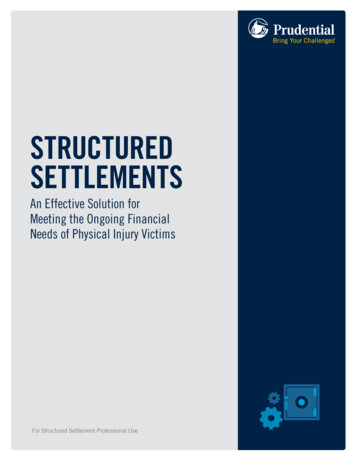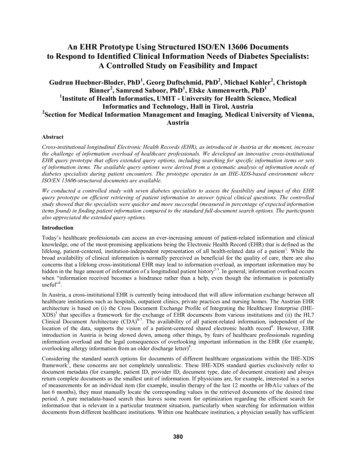
Transcription
An EHR Prototype Using Structured ISO/EN 13606 Documentsto Respond to Identified Clinical Information Needs of Diabetes Specialists:A Controlled Study on Feasibility and ImpactGudrun Huebner-Bloder, PhD1, Georg Duftschmid, PhD2, Michael Kohler2, ChristophRinner2, Samrend Saboor, PhD1, Elske Ammenwerth, PhD11Institute of Health Informatics, UMIT - University for Health Science, MedicalInformatics and Technology, Hall in Tirol, Austria2Section for Medical Information Management and Imaging, Medical University of Vienna,AustriaAbstractCross-institutional longitudinal Electronic Health Records (EHR), as introduced in Austria at the moment, increasethe challenge of information overload of healthcare professionals. We developed an innovative cross-institutionalEHR query prototype that offers extended query options, including searching for specific information items or setsof information items. The available query options were derived from a systematic analysis of information needs ofdiabetes specialists during patient encounters. The prototype operates in an IHE-XDS-based environment whereISO/EN 13606-structured documents are available.We conducted a controlled study with seven diabetes specialists to assess the feasibility and impact of this EHRquery prototype on efficient retrieving of patient information to answer typical clinical questions. The controlledstudy showed that the specialists were quicker and more successful (measured in percentage of expected informationitems found) in finding patient information compared to the standard full-document search options. The participantsalso appreciated the extended query options.IntroductionToday’s healthcare professionals can access an ever-increasing amount of patient-related information and clinicalknowledge, one of the most-promising applications being the Electronic Health Record (EHR) that is defined as thelifelong, patient-centered, institution-independent representation of all health-related data of a patient1. While thebroad availability of clinical information is normally perceived as beneficial for the quality of care, there are alsoconcerns that a lifelong cross-institutional EHR may lead to information overload, as important information may behidden in the huge amount of information of a longitudinal patient history2-3. In general, information overload occurswhen “information received becomes a hindrance rather than a help, even though the information is potentiallyuseful”4.In Austria, a cross-institutional EHR is currently being introduced that will allow information exchange between allhealthcare institutions such as hospitals, outpatient clinics, private practices and nursing homes. The Austrian EHRarchitecture is based on (i) the Cross Document Exchange Profile of Integrating the Healthcare Enterprise (IHEXDS)5 that specifies a framework for the exchange of EHR documents from various institutions and (ii) the HL7Clinical Document Architecture (CDA)6-7. The availability of all patient-related information, independent of thelocation of the data, supports the vision of a patient-centered shared electronic health record8. However, EHRintroduction in Austria is being slowed down, among other things, by fears of healthcare professionals regardinginformation overload and the legal consequences of overlooking important information in the EHR (for example,overlooking allergy information from an older discharge letter)9.Considering the standard search options for documents of different healthcare organizations within the IHE-XDSframework5, these concerns are not completely unrealistic. These IHE-XDS standard queries exclusively refer todocument metadata (for example, patient ID, provider ID, document type, date of document creation) and alwaysreturn complete documents as the smallest unit of information. If physicians are, for example, interested in a seriesof measurements for an individual item (for example, insulin therapy of the last 12 months or HbA1c values of thelast 6 months), they must manually locate the corresponding values in the retrieved documents of the desired timeperiod. A pure metadata-based search thus leaves some room for optimization regarding the efficient search forinformation that is relevant in a particular treatment situation, particularly when searching for information withindocuments from different healthcare institutions. Within one healthcare institution, a physician usually has sufficient380
search tools available for searching within structured or unstructured information and documents in the local EHR.However, this is not the case in the Austrian IHE-XDS based cross-institutional EHR system, which only allows forsearching and exchanging of complete documents.Our basic assumption is that physicians using cross-institutional EHR systems need extended search options tofulfill their information needs and to address the challenge of information overload. Instead of relying on documentmetadata only, these extended search options should allow to search for specific content within structured EHRdocuments. This would give the physicians the possibility to search for specific information items (for example,HbA1c values or allergy information) in all documents within the Austrian national EHR system independent of theinstitution where the documents are located.In today’s heterogeneous world of health information technology, with many different EHR systems on the market,the employment of EHR standards is a prerequisite for interoperability10. ISO/EN 1360611, Health Level Seven(HL7) Clinical Document Architecture (CDA)12 and openEHR13 are the currently most important standards for thespecification of the contents of structured EHRs. All three aforementioned standards support the so-called “dualmodel approach”, which uses separate information and knowledge layers to model EHR contents.This dual-model approach combines a static reference model with so-called archetypes (resp. templates in HL7diction). Archetypes represent EHR contents14 by means of standardized, computer-processable specifications. Theyare expressed in the Archetype Definition Language15 and specify individual EHR contents by constraining thereference model16. As an example, an archetype specifying EHR content “blood pressure” defines, among otherthings, the structure of its content “systolic blood pressure” (compare Figure 1).archetype (adl version 1.4) openEHR-EHR-OBSERVATION.blood pressure.v1[.]OBSERVATION[at0000] matches {-- Blood Pressure[.]ELEMENT[at0004] occurrences matches {0.1} matches {-- Systolicvalue matches {C DV QUANTITY property [openehr::125] list [.]units "mm[Hg]" magnitude 0.0. 1000.0 precision 0 [.]}Figure 1: Fragment of an archetype, specifying a blood pressure measurement. Adapted .ac.at/msi/arche), we developed an EHR prototype that offers an extended search forspecific information items of distributed structured archetype-based documents within an IHE-XDS-basedenvironment18. As an exemplary medical application domain, we chose the treatment of diabetes mellitus (DM)patients.This EHR Arche prototype responds to clinical information needs of diabetes specialists that we identified using acombination of literature review, guideline analysis, observations of patient encounters and interviews withclinicians19. We identified 446 distinct information items (such as “recent blood pressure”, “smoking habits” or“recent medication”) and structured them in nine categories. Based on these data, ten clinical situations (such as“initial medical interview” or “routine check-up”) and the related information items could be described19. The 446identified information needs were then represented by 128 ISO/EN 13606 archetypes20. The IHE-XDS-conformEHR Arche prototype was then implemented and now offers extended search options for these information items instructured ISO/EN 13606 document (for more details of the prototype, see below).Our expectation was that these extended search options are beneficial for responding to the identified informationneeds of the diabetes specialists. To evaluate this assumption, we conducted an evaluation study regarding feasibility381
and impact on time effort and quality of information retrieval. The objective of this paper is to report on the resultsof this evaluation.Background: The EHR Arche prototypeArchitecture of the EHR Arche prototypeOur objective was to use existing IHE-XDS actors and interfaces5 wherever possible. We therefore prepared an IHEXDS-based architecture (compare Figure 2) that comprised the following actors18:(a) Document Repository Actor that persistently and securely stores clinical documents(b) Document Registry Actor that manages a standardized set of metadata for each registered medical document(c) Document Consumer Actor that allows to query and retrieve both unstructured (PDF) and structured archetypebased documents, allowing to search both for individual information items and for combinations of items(d) Document Crawler Actor that processes the queries sent by the Document Consumer and then uses either astandard XDS document query to retrieve a full PDF document or an extended content-based query to retrievedistinct information items from archetype-based documents(e) Archetype Repository that contains the 128 ISO/EN archetypes corresponding to the identified information itemsfor diabetes specialistsThe prototype is available at: r.Figure 2: Architecture of the EHR Arche prototype, combining standard and extended IHE-XDS actors.User interface for standard and extended search within the EHRThe Document Consumer of the EHR Arche prototype contains two parts:1.A standard search interface for querying documents by using standardized IHE-XDS document metadata suchas author of document, creation date or document type. The search retrieves PDF documents (such as dischargeletters or laboratory results) from the lifelong cross-institutional EHR, corresponding to the selected metadata.The user than can browse through the PDF documents to identify the needed information. This standard searchinterface represents the way physicians search within the Austrian EHR system already today.2.An extended search interface (Figure 3) for searching for specific information items or pre-defined collectionsof information items. These pre-defined queries reflect the 446 information needs when treating diabetespatients, as analyzed in a previous study19. The information items are internally referred to via codes of a382
terminology (for the proof-of-concept, we used a local terminology), to which corresponding archetype nodeswere mapped within the archetype ontology section. This indirection enables a future search for synonymousinformation items and a search for different archetype nodes (e.g. also based on reference models of differentEHR standards) that semantically correspond to the same information item. Figure 4 shows how the retrievedresults (that is, the specific information items) are presented to the user. This extended search option is new andnot yet available for the Austrian EHR system.Figure 3: Frontend of the EHR Arche extended search interface: The user can choose whether to search for clinicalinformation based on single information items (1). These single information items reflect the identified 446information needs, for example, “medication” or “smoking” or “HbA1c” or “parathormone”. Alternatively, the usercan use pre-defined queries that search for a combination of information items (2). For example, “Erstgespräch” ( initial medical interview) includes around 200 information items that are of interest during a first encounter with adiabetes patient, while “Routinekontrolle” ( routine check-up) contains 42 information items. In both cases, the ageof the document where the information is contained can be determined (for example “letzte 6 Monate last sixmonths”).383
Structured presentation of content12345Figure 4: Frontend of the extended result presentation: Each line stands for an information item. The informationitems (3) are organized into logically connected groups (2). Each column represents a single document whichcontains the given information item. For each document, the value of the information item is displayed (4), either inqualitative or quantitative form. It is also possible to retrieve and display the full document by clicking on thedocument name (5).MethodsOur evaluation questions were as follows:1.Is using the extended search interface more successful in fulfilling clinical information needs than the standardsearch interface? Thus, is searching for information items in structured documents more successful thansearching in full-text (PDF) documents only?2.Does the extended search interface help to more quickly fulfill clinical information needs than the standardsearch interface?3.How satisfied are the users with the extended document query interface? Do they feel it better responds to theirinformation needs? Is the overall approach feasible?Study designWe conducted a controlled study combining a formative and a summative evaluation. Success (study question 1)was measured by percentage of expected information types found, efficiency (question 2) was measured by time toanswers within 20 min., and user satisfaction (question 3) was measured through a standardized survey. We thusused methodical triangulation, combining observations, interviews and a survey, to systematically aggregatedifferent perspectives of the investigated object21.A medical expert prepared realistic test cases of two diabetes mellitus patients with related numerous complicationsand therapeutic interventions. For each patient, around 60 documents were prepared, such as discharge letters fromvarious institutions (for example, from an internist, a neurologist, a dermatologist and a general practitioner) andreports of various examinations (for example, lab results and patient self-measurements). Each document was made384
available both in unstructured form (PDF document) as well as in identical form as structured, archetype-baseddocument (ISO/EN 13606).For each patient, we prepared a clinical scenario describing a typical doctor’s consultation: a routine check-up of anunknown diabetes patient. Each scenario comprised five clinical questions that the physician typically may want torespond. The clinical questions were derived from typical information needs analysis of diabetes specialists19 andcomprised questions on:1.Family history2.Overview on general disease status and medication3.Specific clinical questions related to individual problems and further treatments. Example: “Thedermatologist suggests a debridement on both feet with an accompanying antibiotic therapy. The patienttells you that she poorly tolerated the last antibiotic therapy, but she doesn’t know the name of themedicament.”For each clinical question, we defined a gold standard that presented the best available answer that could be obtainedbased on the available EHR data. For the example (3.) given above, the gold standard is: “Drug intolerance toCephalexin/Ospexin”, this information being contained in the discharge letter from Oct. 5, 2010. Some clinicalquestions could only be answered by more than one information item – for example, questions on the lastmedication of the patient. Altogether, the first patient case scenario comprised five clinical questions with theexpected answers comprising 30 information items; the second patient case scenario comprised five clinicalquestions with the expected answers comprising 27 information items.Seven diabetes specialists from Vienna and Tyrol with specialization in diabetes mellitus participated in the study.Six of them came from the diabetes outpatient clinics of four different hospitals and one from a private practice. Weorganized a two-hour appointment with each of these participants.Study flowFirst, each participant was given an introduction to the study and a training session on the EHR Arche prototype.Then the first patient case scenario was presented and the pre-defined clinical questions were asked. We asked theparticipant to find the correct answer to each question by using the EHR Arche prototype. For one patient casescenario, the participant was asked to use the standard search interface that only allows searching and retrievingPDF documents. For the other scenario, the participant was asked to use the extended search interface that allowedsearching for individual information items from the structured EHR documents. The order of scenarios was changedfor each participant. Interfaces and scenarios were not tied, but balanced to minimize order effects (see Table 1).Overall, as we had seven participants, we performed 14 scenarios: seven cases with the extended search and sevencases with the standard search.Each participant was monitored by one observer while trying to solve the patient cases. The observer documentedthe found answers to the clinical questions. The time for answering the questions in each scenario was limited to 20minutes to reflect a typical clinical encounter in the chosen clinical setting.After finishing both scenarios, the participants answered a short written survey to document their first impressions ofusing structured documents to answer clinical questions. This survey polled participants on their assessment ofsearching and accessing information, on usability and on user friendliness. Overall, the survey comprised 16 closedquestions on a 4-point Likert scale. In addition, we conducted a semi-structured expert interview with eachparticipant to discuss questions of usefulness and feasibility as well as ideas for improvement. These interviewswhere audio-recorded and transcribed.Data analysisThe survey results and the answers to the clinical questions were analyzed using quantitative descriptive dataanalysis. Performances (success rate of finding the answers to the clinical questions) between extended search andstandard search were compared using the Wilcoxon-Mann-Whitney U test with alpha set to 5%. The interviews andfield notes from the observations were analyzed using inductive summative content analysis.385
ResultsFive of the participants reported being very familiar with using the computer, two participants reported havingmedium familiarity. All seven participants stated having great interest in eHealth issues and health informationexchange.Success of finding informationUsing the extended search, all participants were able to answer all clinical questions correctly within the time limitof 20 minutes. Using the standard search, the overall performance was lower with around 80% success rate (Table1), meaning that 20% of the expected information items could not be found within the time limit. The differencesbetween extended search and standard search are significant for both patient scenarios (p 0.007 resp. p 0.002).Table 1: Success in finding the expected information items and ability to answer the clinical questions. Overall,seven physicians participated. Patient A: 30 information items to be found. Patient B: 27 information items to befound.Success rate using extended searchSuccess rate using standard searchParticipant No. 1100% (patient A)88.9% (patient B)Participant No. 2100% (patient A)88.9% (patient B)Participant No. 3100% (patient A)74.1% (patient B)Participant No. 4100% (patient A)77.8% (patient B)Participant No. 5100% (patient B)100% (patient A)Participant No. 6100% (patient B)66.7.% (patient A)Participant No. 7100% (patient B)70% (patient A)Mean performance ratePatient A: 100%Patient A: 78.9%Patient B: 100%Patient B: 82.4%Time needed for answering the clinical questionsWhen using the extended search, all participants were able to find the correct answers to the clinical questionswithin the given time frame of 20 minutes. Answering all questions took the participants between 10 and 14 minutesfor the first patient case scenario and between 8 and 12 minutes for the second patient case scenario.When using the standard search, only one participant (No. 5, see Table 1) was able to find the correct answers to allclinical questions in the given time frame. The others had to stop the search after 20 minutes.Search patterns when searching for clinical information (results from observations)While observing the participants when using the metadata-based query, all participants started retrieving the mostrecent 3 – 4 documents from the EHR (7 cases). In addition, depending on the clinical question, they also searchedfor older documents within certain clinical areas (for example, dermatology results) (5 cases) or they went throughall older documents in chronological order until they found the needed information (2 cases). We observed thatparticipants were quite used to scrolling quickly through PDF documents to find specific requested informationitems (6 cases). The need to open and close many PDF documents was found cumbersome by participants (5 cases)and participants expressed not being able to capture the complete content of a PDF document in a short time (4cases). One user used the search functionality in Adobe Reader to search for information in the PDF documents.While observing the participants when using the extended query, we found that participants combined pre-definedqueries (7 cases) with the search for individual information items (6 cases). One problem for the participants was torecognize cases where information items were contained identically in several documents (4 cases). In other cases,participants had difficulties identifying in which documents the found information items were contained, especiallyin cases where several items for one document were presented (4 cases). Regarding usability, 23 suggestions wereretrieved from the observations to improve the user interface of the prototype, such as showing only one information386
item in cases where identical items are contained in several documents, or highlighting the date of an informationitem.Participant’s assessment of the extended search options (results from user survey)The following numbers show the answers of the seven participants to the written standardized survey:1.2.3.4.5.6.7.8.9.10.11.The extended search is simple and self-explaining to use: n 1 partly agree, n 6 fully agreeThe extended search is more intuitive than the standard search: n 6 fully agree, n 1 no answer.The extended search is more complicated than the standard search: n 7 fully disagreeThe extended search is quicker than the standard search: n 7 fully agreeMedical data found in the extended search are clearly presented: n 4 partly agree, n 3 fully agree.Medical data found in the standard search are clearly presented: n 3 partly disagree, n 4 fully disagreeThe pre-defined queries are useful to obtain an overview about a clinical situation: n 7 fully agreeInformation overload is better manageable with the extended search: n 7 fully agreeInformation overload is better manageable with the standard search: n 7 fully disagreeIt makes sense to further develop software tools to support searching in clinical documents: n 7 fully agreeI would like to have access to a longitudinal electronic record of my patients: n 1 partly agree, n 6 fully agreeOverall participants’ assessment of the feasibility of the chosen approach (results from the interviews)When discussing the metadata-based standard query options, the participants stated that it is difficult to find neededinformation because a great amount of data is normally not retrievable due to the large number of documents (n 2).They also stated that it is often unclear whether found information is complete (n 1). One participant stated that it isvery time-consuming to retrieve information from full-text documents (n 1) and three participants stated thatdischarge letters from different institutions are often structured differently, making information retrieval moredifficult (n 3).Regarding the extended query, the participants stated that the extended search was intuitive in use and worked well(n 5) and that it helps to respond to their personal needs (n 4). The experts especially found the pre-defined queriesvery helpful (n 7). However, they also wanted to have the possibility to adapt the pre-defined query to their specificneeds (n 4). The participants found it legally important to be sure that the presented information items are completeand correct (n 3). The good response time (n 4) and the design of the pre-defined queries (n 3) were positivelymentioned. The participants made nineteen suggestions to improve the user interface. Three participants expressedtheir interest in using the tool as soon as it is available in routine care.DiscussionAlready in 2004, Godlee et al discussed the future of health information management22. They cited a reportdemanding that people accessing health information “should be given the chance to say what they want rather thansimply be sent information”. This simple idea was the basis for the EHR Arche prototype: Instead of simplyproviding a set of documents that physicians need to go through by hand, physicians now have the opportunity tostate their information need in the form of a query and to get the specific information responding to this need.The usage of archetypes within health information systems has been discussed for some years now and research hasbeen conducted on the question on how to define archetypes and how to use them for documentation. However, asfar as we know, our study is the first attempt to map systematically identified information needs to archetypes and touse these archetypes to develop a query interface allowing searching for (sets of) information items.The EHR Arche prototype was found to be sufficiently stable and performant. In the survey, and confirmed by theinterviews, all participants appreciated the concept of extended search and preferred the extended search opportunityover the (quite familiar) metadata-based standard query options that retrieve single documents and not specificinformation items.We have focused on the setting “diabetes mellitus treatment”. We included diabetes specialists from severalhospitals as well as internists to ensure that the results not only reflect the situation in one institution. Mostparticipants reported being quite familiar with computers; this may explain why they did not have greater difficultiesin handling the unfamiliar prototype. We tried to create realistic, yet complex patient scenarios. The scenarios weredeveloped based on observed clinical encounters and should thus reflect typical complex cases in an outpatientclinical setting.387
While we have focused on the setting “diabetes mellitus treatment”, the overall approach and architecture seem to begeneralizable to other clinical settings, although we did not investigate this yet. We developed the EHR Archeapplication in a way that it can handle any list of information items and queries as well as any list of relatedarchetypes.The time needed to develop the pre-defined queries was quite high. We expect that the information needs in aspecific clinical situation do not differ much at different healthcare institutions, which would mean that the predefined queries of one site can be re-used (perhaps in a slightly adapted form) at another site. However, this stillneeds to be further verified. In addition, it is unclear whether it is possible to identify specific information needs in amore general clinical setting such as at a general practitioner.The time needed to answer the clinical questions of the scenarios by using the standard search was much longer ( 20 minutes) than when using the EHR Arche prototype (8 – 14 minutes). In addition, the success rate was muchlower (around 80% versus 100%). At first glance, these results may not be too surprising, as searching in structureddocuments may intuitively be considered to be more efficient. However, using a query editor to search in structureddocuments is unfamiliar and may be considered complicated and even more time-consuming than simply retrievingPDF documents. In addition, presenting long lists of information items separated from their context may be regardedas risky, not informative and may even lead to an increased feeling of information overload. The results of ourstudy, however, do not support these concerns. On the contrary, our participants found querying structureddocuments based on identified information needs useful and more efficient.We observed that, in the standard search, all participants first focused on the most recent 3 – 4 clinical documentswhen searching for information, sometimes additionally retrieving selected older documents. Participants confirmedthat this is the usual way of searching within a large number of EHR documents given the time constraint of atypical clinical encounter. This approach is successful to retrieve most recent information (when using the standardsearch, we had a success rate of around 80%), but clearly tends to fail in cases where the course of a disease needs tobe analyzed over a longer time period or where older information (for example, older information from the familyhistory or an old clinical note on a medication allergy) needs to be retrieved. Participants stated that focusing on the3 – 4 most recent documents often leaves them unsure whether further important information may be contained inother documents which they did not find time to look at. On the contrary, when using the extended query, they seemto feel more secure, as they can retrieve all information from the last few months or years, so the danger ofoverlooking older information is reduced.Some research has been conducted on the possibility to conduct free-text searches in EHR documents23. Thisapproach gives the user the freedom to
diction). Archetypes represent EHR contents 14 by means of standardized, computer-processable specifications. They are expressed in the Archetype Definition Language 15 and specify individual EHR contents by constraining the reference model 16. As an example, an archetype specifying EHR content "blood pressure" defines, among other
